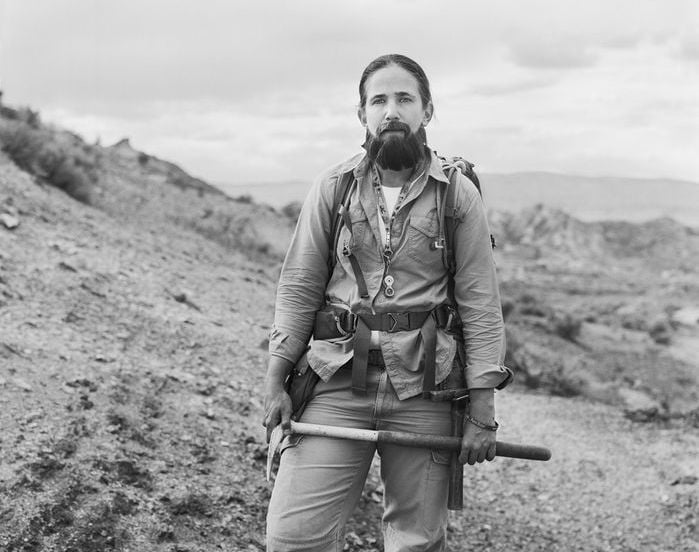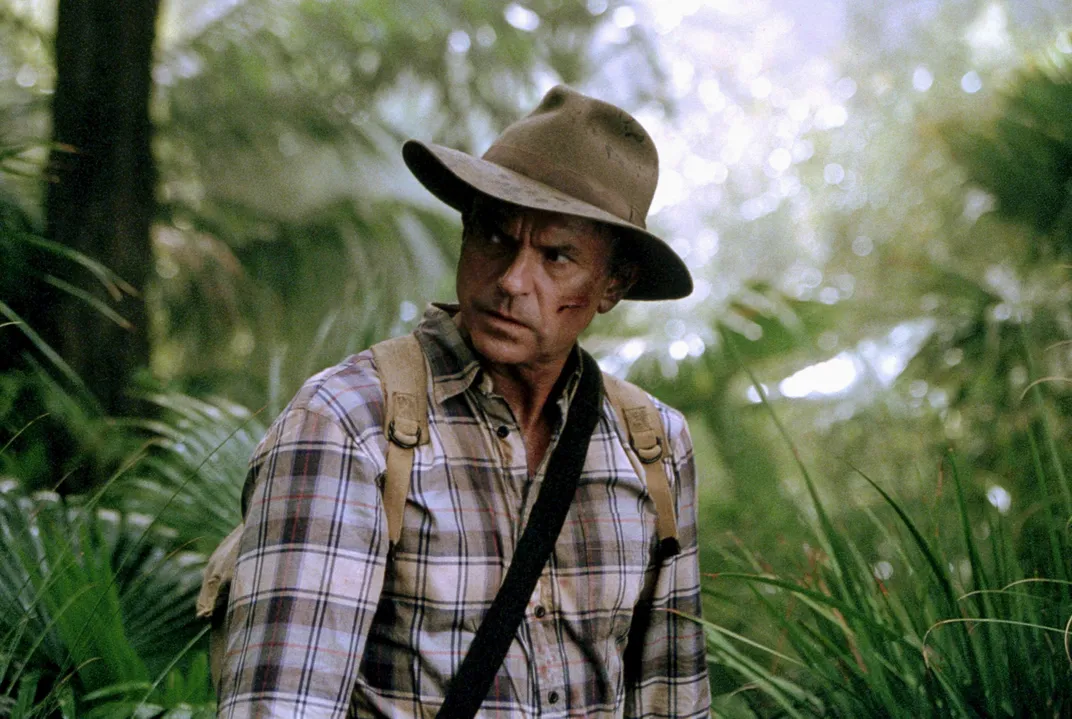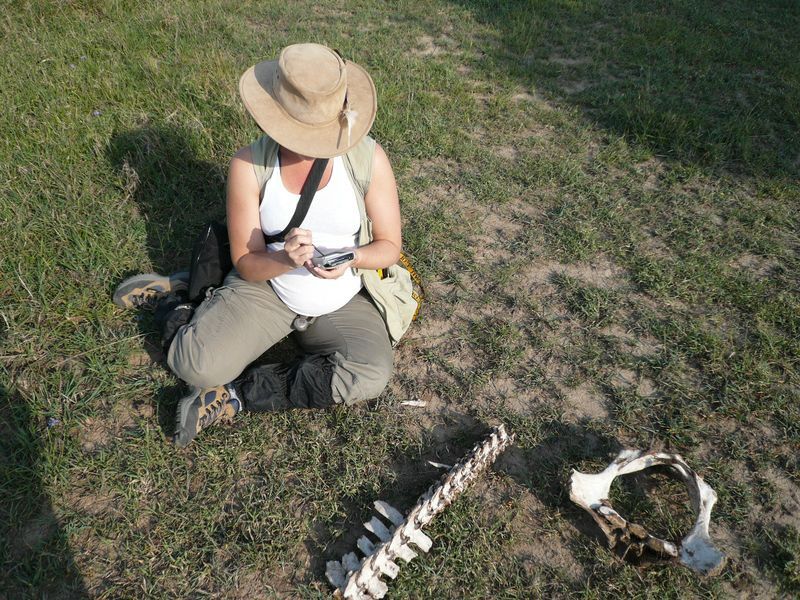The Many Ways Women Get Left Out of Paleontology
The hurdles that prevent female fossil hunters from rising at the same rates as their male peers are myriad—but they are all interconnected
:focal(380x175:381x176)/https://tf-cmsv2-smithsonianmag-media.s3.amazonaws.com/filer/1e/98/1e985df2-f72d-4d5b-87ae-e376de54f027/paleontology6.jpg)
You can’t talk about the early days of paleontology without talking about Mary Anning. Far from being just the inspiration for the tongue-twister “she sells seashells down by the seashore,” the pioneering fossil hunter helped shape the young field, collecting and studying Jurassic remains in a time when science was openly hostile to women. Despite being kept out of scientific societies and seeing her stunning discoveries published by her male peers, Anning made herself a scientific icon. Her work digging up toothy sea monsters around the English countryside has been memorialized in book-length biographies, novels—and even a 2018 film.
It’d be comforting to think that we’re beyond the days when Anning had to fight as fiercely to be recognized as the prehistoric creatures she uncovered. But the arc of history does not always bend toward equality. Two centuries after Anning’s trowelblazing efforts, the enterprise of paleontology still presents numerous challenges to women wanting to follow in her footsteps. Anning herself often ends up standing in for all women in paleontology by default—just as, when you ask someone their favorite female scientist, Marie Curie is often the only one they can name.
Yet while generations of researchers have chipped away at the male-dominated culture of paleontology, a gap remains. Women today make up nearly half of student members in organizations like the Society of Vertebrate Paleontology, but, Ohio University paleontologist Catherine Early notes, less than one-quarter of professional members—people with staff jobs like curator or professor—are women. The reasons range from subtle discrimination to direct sexual harassment, but they are all interrelated. From the classroom to the field, women are still trying to dig out from the attitude that paleontology is a boys’ club.
Smithsonian.com spoke to multiple women paleontologists and researchers about what they see as the most pressing gender-related problems in their field.

Unsafe In the Field
It's only in the past few years that the true extent of harassment in scientific fieldwork has come to light. Some of the best data we have comes from anthropologist Kathryn Clancy and colleagues, who in 2014 reported that in a survey of 666 field scientists across disciplines, 64 percent said they had faced some form of sexual harassment in the field and over 20 percent had been sexually assaulted. The pattern was clear: victims were of lower professional rank than their harassers, many of whom felt they were in no position to report their abusers. “Women trainees were the primary targets” of abuse, the researchers found, while “their perpetrators were predominantly senior to them professionally within the research team.”
Vertebrate paleontology is no exception. Professional paleontology expeditions are generally run under the auspices of museums and universities. However, often held during the summer at remote dig sites, they have a much more relaxed feel, like a camping trip with a scientific mission. That isn’t necessarily bad; fieldwork generates stories and friendships as well as hard data. But it can also create dangerous situations where victims are isolated with harassers and predators.
How a field expedition is run and the way a camp is managed largely rests on the principal investigator, says Cleveland Museum of Natural History paleontologist Denise Su, who has been part of expeditions from Yunnan, China, to Manonga Valley, Tanzania. Each camp is as different as the people running them, with no discipline-wide standard or enforcement. Yet a follow-up study published by Clancy and colleagues in October 2017 found that these expeditions tend to have one thing in common: They neglect to lay out clear expectations of professional behavior or policies of what to do about sexual harassment.
Having been on dozens of university- and museum-led field expeditions and reporting on paleontology in the American West for seven years, I’ve noticed this inattention during fieldwork myself. More time is given to field gear and how to use a GPS than acceptable conduct, where crises are often dealt with after the fact, if at all. Field workers are told to bring sunscreen, for instance, but not who to contact in the case of assault. “In my experience,” says AAAS Science and Technology Policy Fellow and paleontologist Shaena Montanari, “a lot of field expeditions start without a proper emergency and sexual harassment plan being clearly laid out to everyone.”
Of those surveyed in the 2014 study, only 38 percent were aware of any code of conduct at their field site. Just 22 percent knew of any sexual harassment policy. “Few respondents were aware of mechanisms to report incidents; most who did report were unsatisfied with the outcome,” Clancy and colleagues wrote in their study.
While more bad behavior is becoming exposed, she adds, victims often feel like they have little recourse. In 2017, Science Magazine reported on multiple accusations of verbal and physical harassment and assault against prominent geologist David Marchant. Four of the women told reporter Meredith Wadman that they considered reporting the abuse—but ultimately waited years, or never did. They cited fears of career repercussions, as well as feeling dissuaded after meeting with faculty. “The number of women have been so low (as) to prevent women from speaking out”—especially when they’re alone, isolated with their harasser who might be running the trip, says University of Calgary paleontologist Jessica Theodor.
There can be institutional consequences to how reports of harassment are dealt with, depending on how the expedition was organized. University-led trips fall under Title IX—the 1972 law that prohibits discrimination based on sex in educational institutions that rely on federal funding. That law makes the university legally responsible if it chooses to ignore incidents of sexual harassment or assault. In the case of museums, Theodor notes, action depends on an administration willing to do so.
Theodor believes it’s the responsibility of camp leaders to be the example for those they’re leading. “If I’m setting the tone by not drinking heavily and acting in a particular way (on an expedition), then people won’t pull that,” Theodor says. Binge drinking—a stereotype in the field—and a climate where women are alienated or discriminated against, she adds, shouldn’t be taken as a given. “It doesn’t have to be this way and shouldn’t be this way."

Subtle Discrimination
Of course, the discrimination women face in the field can be far less obvious than direct harassment at the hands of those like Marchant. “Just being a women field paleontologist has layers of complexity,” Su says. It starts long before expeditions pile into their vehicles and rumble off to the outcrop: For many, success is cast against a background of constantly coping with unreasonable obstacles. “You really have to want it to put up with a lot of crap,” Su says.
Whether from members of the field crew themselves or people researchers need to work with in remote places, Su says, there is often an underlying assumption that women aren’t as skilled, tough or driven as the men. There’s a feeling that “you can’t stop or rest because you’ll be judged,” Su says.
Briana Pobiner, a Smithsonian National Museum of Natural History paleoanthropologist, says this can be especially prominent in graduate school. “I wanted to prove I could work just as hard” as the male instructors in the field, Pobiner recalls. Despite this, men are often given more slack when it comes to field behavior (as I’ve also experienced during fieldwork). There’s an impression that male paleontologists can gain legendary status for being late, drunk or reckless, Su notes, yet women constantly feel excess pressure to be perfect in every respect lest they lose their invitation to dig. “We take for granted that this is the way things are,” Su says.
The isolation of the work doesn’t help. “You’re usually the only woman in the field,” Su says—and there are some biological realities that just don’t occur to men, from periods to pregnancy.
University of Georgia anthropologist Suzanne Pilaar Birch, for instance, has written about coping with pregnancy while in remote places. “Men don’t have to worry about what kind of anti-malarial medication is safe when you’re pregnant or trying to conceive," Pobiner adds. Pobiner is bringing her young son out to fieldwork in Kenya for the first time this year, and says the experience of other scientist mothers paved the way for her to do the same. She recalls being in the field “with Kay Behrensmeyer over a decade ago, when she brought her husband and two then-young daughters, and even though I was far from thinking about starting a family then, I was watching to see how she did it.”
There are also the more daily realities—like finding a place to pee that has enough cover, Su says, while worrying that such a delay will be looked down upon as holding up the team.
Beyond the disadvantage to women themselves, the lack of women on field teams can be a practical disadvantage to science.
“It’s hugely beneficial to have a diverse set of people on a field team,” says University of Toronto paleontologist Victoria Arbour. “If everyone has the same background, your ability to come up with efficient ways to solve problems is going to be reduced. You need groups of people who are willing to work hard, use the tools and resources at hand, make good contingency plans, be organized and detail-oriented, and think outside the box when things aren’t working out.”
Tough Guy Hunting Fossils
The public image of paleontologists as Indiana Jones-type characters doesn’t help any. Through decades of science popularization, we’re left with the image of a paleontologist as a scruffy white man in a cowboy hat. Paleontologists such as Jack Horner and Bob Bakker have even served as the inspiration for characters in the Jurassic Park movies, standing in as stereotypical paleos who represent the entire field in the minds of the public. (The documentary and photography project The Bearded Lady Project is a cutting parody of this exact trope.)
What that means is that for the public—and for those seeking to break into paleontology—is that the image of paleontology is overwhelmingly white and male.
“When you watch many, many documentaries, even ones coming out this year,” Montanari says, “it looks like white men run the world of paleontology, which simply isn’t true.” The same group of talking heads can be seen on most basic cable dinosaur programs, like Discovery Channel's "Dinosaur Revolution," with women rarely included and almost never interviewed during fieldwork. “I shouldn’t be watching a dinosaur documentary in 2018 and seeing a grand total of zero women or people of color in the film,” Montanari says.
In reality, of course, women paleontologists have been contributing to and driving the field since the beginning, from Anning to the experts mentioned in this piece to others such as Emily Lindsey of the La Brea Tar Pits, University of Colorado at Boulder’s Karen Chin, Anusuya Chinsamy-Turan from the University of Cape Town, and more. But recognition is hard won and relatively recent—and the perception of the field has yet to catch up. “The tide has pretty much changed already, many women are running large field programs and research groups, but men continue to get tapped for opportunities where they are publicly visible,” Montanari says.
This includes public outreach events where museums overwhelmingly ask male paleontologists to speak instead of women. The annual PaleoFest meeting at the Burpee Museum of Natural History was criticized for falling short on gender representation, for example, and in 2016 held a “Women in Paleontology” session in response. These kind of one-off events won’t fully remedy the problem, but at least the 2018 slate of speakers is more even than it had been previously.
Still, the fight for fairer representation continues. As Arbour has pointed out, for example, the 2011 documentary Dino Gangs not only failed to feature any women paleontologists, but also ignored Yuong-Nam Lee—the leader of the International Dinosaur Project the film followed. But there is a simply way to remedy this issue, says Arbour: Media-savvy favorites who often get booked for interviews need to make more of an effort to share the spotlight. “If I could offer some advice to people who get to have the opportunity to speak to the media regularly,” Arbour says, “it would be to also put forward names of colleagues who don’t get that opportunity as often.”
Whether dealing with practical concerns or outreach, paleontology is still stifled by diversity gaps. Members of the LGBTQ+ community, for instance, are only beginning to gain visibility and have been running their own annual gathering at the Society of Vertebrate Paleontology conference.
These issues seep deeply into the discipline. If you’re anyone other than a white male, it’s going to be a challenge to find anyone who looks like you to identify with in paleontology outreach. “All-white-male-panels are often not created with malicious intent or to purposely exclude people, I’m sure,” Montanari says, “but if your ideal of a ‘real’ paleontologist is seven white guys, take a minute to examine why that is.”

Chipping Away at The Problem
The representation gap is improving. The Bearded Lady Project, Trowelblazers, the appearance of paleontologists like Arbour on shows such as “Dino Hunt Canada,” and the book She Found Fossils by Eugenia Gold, Abagael West, and Amy Gardiner are all changing what once seemed set in stone.
Harassment policies, too, are slowly changing. In 2015, the initial survey by Clancy and her colleagues helped prompt the American Association of Physical Anthropologists to recognize the need for a specific statement against sexual harassment, in addition to their general code of conduct. The group published such a nine-page statement that year, which was adopted by both the Paleoanthropology Society and Society of American Archaeology. It specifically cites the dangers of sexual harassment in field work and and offers concrete ways to combat harassment, including the recommendation that principle investigators “enforce field-site specific codes of conduct.”
In addition, just last year the American Geophysical Union moved to consider sexual harassment to be scientific misconduct on par with fabricating results or plagiarism. (Unfortunately, these groups are not legal bodies and cannot legally enforce these policies.)
Theodor agrees that making clear rules ahead of time is a major step forward in changing the culture. At the University of Calgary, “we put in place a formal policy in field schools,” Theodor says, having students “sign a policy that they would be responsible adults.” The Signaling Safety study by Robin Nelson and colleagues backs this up, finding a drop in harassment and other forms of discrimination against women when clear camp rules were present and enforced.
These changes reinforce a key truth: discrimination against women paleontologists is a reality, but it is not inevitable. The paleontologists I spoke to said that those already in positions of prominence and power can take simple, tangible steps—such as articulating and enforcing codes of conduct, and even recommending their women peers for gigs like documentary commentary—that will peel back barriers that have plagued the science from the start.
The burden to make these changes can’t all be on women—continuing the exhausting push for equality requires men to be part of the conversation, too, stress Su and Theodor. “With sexual harassment and assault so prevalent at field sites, I think it’s imperative that any principal investigator or field leader craft a crystal clear code of conduct,” Pobiner says. It's not just a matter of expectations, but a way to safely report and respond to incidents in places often far removed from the classroom.
Paleontology at-large has avoided having this conversation—and creating and enforcing these standards—for too long. There’s still a long way to go, with each field season raising the question of what kind of science paleontology will choose to be: one that values equality and diversity, or a discipline that is as moribund as its petrified subjects.
“Someone opened the door for me,” Su says. “I want to make sure it stays open, and opens wider.”
/https://tf-cmsv2-smithsonianmag-media.s3.amazonaws.com/accounts/headshot/RileyBlack.png)


/https://tf-cmsv2-smithsonianmag-media.s3.amazonaws.com/accounts/headshot/RileyBlack.png)